More thoughts on the enigma of top-down (downward) causation
Downward causation, or top-down causation, is the idea that the whole of a system can influence its parts in ways that cannot be reduced to the local interactions between the parts.
The related but weaker concept of emergence recognizes that higher level system models emerge from lower levels. For example, fluid dynamics and thermodynamics emerge from the physics of interacting particles, and higher levels like biology emerge from lower levels.
It’s often claimed that higher level models can always be derived from (reduced to) lower level physics, at least in principle, but the derivation of thermodynamics (let alone biology) from lower level physics is still elusive.
Top-down causation is a very strong form of emergence where high level laws are considered as able to directly dictate the behavior of the lower levels.
In my book [*] (Chapter 18) I discuss top-down causation and propose an intuitive “visual” model. The idea is that different Everett worlds unfold for a short while (perhaps very short from our perspective), but then most of those worlds evaporate into nothingness, or something like that, while the “fittest” winners take all and become fully real according to certain reality selection criteria, which implement downward causation.
The model is inspired by this observation of genetic programming (GP) researcher Wolfgang Banzhaf (source):
“With the still lingering dispute about whether emergence using downward causation is a valid idea, GPers can confidently declare that emergence is happening in GP for all the world to see. I believe this is due to the presence of selection as one of the driving forces of evolution, a clear case of downward causation.”
I have been thinking more and reading more recent works on strong emergence and downward causation.
In “Artificial Chemistries” (2015) Banzhaf and Lidia Yamamoto note that, according to biologist Denis Noble, “hierarchical systems in biology have layers from which causal influences point to other layers.”
“Why would there be a ‘privileged’ direction of causation only going upward, from each level to the next higher? Influences could be acting in both directions, up and down.”
Irreducible causal power
Banzhaf and Yamamoto discuss the enigma of top-down causation, “the apparent metaphysical unacceptability” of the assumption that emergent phenomena “are both, dependent on underlying processes (at the micro level) and, at the same time, autonomous from underlying processes.”
“Wouldn’t there be a conflict from the top-down causation intervening with what is already going on in causal relationships at the lower level? Wouldn’t the primary cause for behavior of entities at the lower level be their low-level interactions and causes? And where would that leave top-down causation to act on?”
Emergent entities seem to have “irreducible causal power, i.e., causal power that cannot be explained by the causal power of lower-level entities.” But then, it seems that “a causal overdetermination of the behavior of micro-level entities” could lead to contradictions.
However, I think, this is compensated by the UNDERdetermination of micro level physics (e.g. quantum mechanics, strong chaos [*]), which provides causal slack for top-down causation to operate alongside bottom-up causation, with irreducible causal power and without inconsistencies. In “Dance to the Tune of Life: Biological Relativity” (2016), Noble says:
“At the micro level, there is the essential stochasticity of quantum mechanics. Even if, one day, an alternative view of ‘reality’ is produced, as people like Albert Einstein and David Bohm believed, we can’t escape the fact that the equations of quantum mechanics are precisely predictive as probabilistic descriptions. Any underlying determinism would have to reproduce this.”
In my book [*] (e.g. Chapter 18) I elaborate on possible forms of underlying determinism compatible with the essential stochasticity of quantum mechanics.
Perhaps there’s no enigma?
Noble emphasizes that, according to Spinoza,
“every part of nature agrees with the whole, and is associated with all other parts… by the association of parts, then, I merely mean that the laws or nature of one part adapt themselves to the laws or nature of another part, so as to cause the least possible inconsistency.”
My interpretation of this very intriguing passage is that, perhaps, the solution to the enigma of top-down causation is that there’s no enigma.
We shouldn’t expect to be able to explain top-down causation away, because there’s nothing to explain. Yes, our intuition seems to say that we should be able to to reduce higher levels to lower levels. But perhaps our intuition, which is shaped by centuries of reductionist thinking, and limited to simple mechanical models with local, bottom-up causation, is just wrong in this case.
The view of Noble (and Spinoza) is perfectly logical and consistent: The laws of micro level physics are strictly followed, but leave the actual evolution of physical systems underdetermined, with enough slack for higher level laws of thermodynamics, biology, etc., to be strictly followed as well.
Then, perhaps, there are very high level laws for which we don’t have a name or even a concept yet, and these laws are also strictly followed, all the way up to the top level choices of a cosmic Mind.
[*] My book “Tales of the Turing Church: Hacking religion, enlightening science, awakening technology” is available for readers to buy on Amazon (Kindle | paperback).
Please buy my book, and/or donate to support other Turing Church projects.
Cover picture from Public Domain Pictures, picture from Wikimedia Commons.
